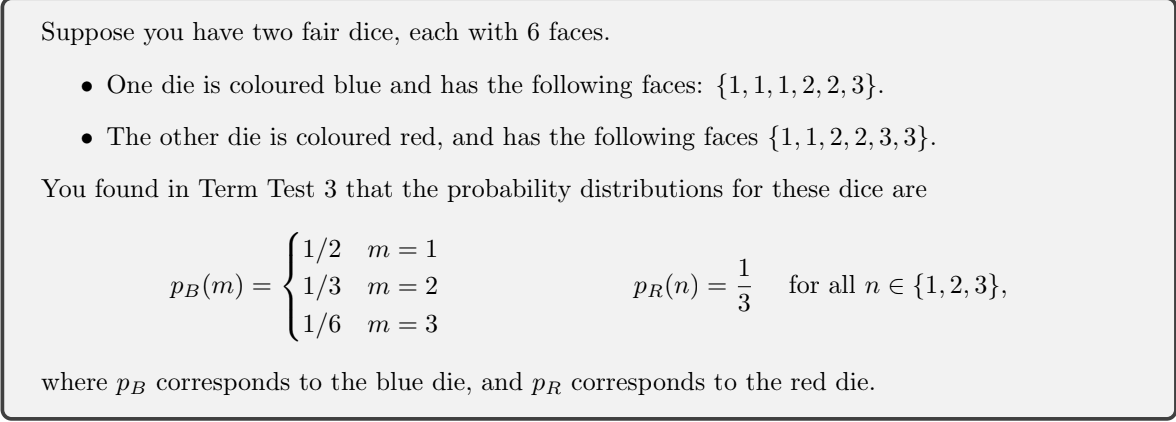Suppose you have two fair dice, each with 6 faces. • One die is coloured blue and has the following faces: {1,1, 1, 2, 2, 3}. • The other die is coloured red, and has the following faces {1,1, 2, 2, 3, 3}. You found in Term Test 3 that the probability distributions for these dice are 1/2 т — 1 1 fon 11
Suppose you have two fair dice, each with 6 faces. • One die is coloured blue and has the following faces: {1,1, 1, 2, 2, 3}. • The other die is coloured red, and has the following faces {1,1, 2, 2, 3, 3}. You found in Term Test 3 that the probability distributions for these dice are 1/2 т — 1 1 fon 11
Algebra & Trigonometry with Analytic Geometry
13th Edition
ISBN:9781133382119
Author:Swokowski
Publisher:Swokowski
Chapter10: Sequences, Series, And Probability
Section: Chapter Questions
Problem 27T
Related questions
Question
Pls help ASAP. pls look at the first pic to do the question.

Transcribed Image Text:Suppose you have two fair dice, each with 6 faces.
• One die is coloured blue and has the following faces: {1,1,1,2, 2, 3}.
• The other die is coloured red, and has the following faces {1, 1, 2, 2, 3, 3}.
You found in Term Test 3 that the probability distributions for these dice are
1/2 m = 1
рв (т) — { 1/3 т%3D 2
1
for all n e {1,2, 3},
3
PR(N)
1/6 m= 3
where pB corresponds to the blue die, and PR corresponds to the red die.

Transcribed Image Text:3. Consider the dice defined in the box at the top of the page. Suppose that you roll both dice. Let E be
the event that the sum of both dice is 4, and let F be the event that the blue die shows an odd number.
(i)
Compute the probability P(E|F).
(ii)
Compute the probability P(E).
(iii)
Compute the probability P(F|E).
Expert Solution
This question has been solved!
Explore an expertly crafted, step-by-step solution for a thorough understanding of key concepts.
Step by step
Solved in 2 steps

Recommended textbooks for you

Algebra & Trigonometry with Analytic Geometry
Algebra
ISBN:
9781133382119
Author:
Swokowski
Publisher:
Cengage


Algebra & Trigonometry with Analytic Geometry
Algebra
ISBN:
9781133382119
Author:
Swokowski
Publisher:
Cengage
